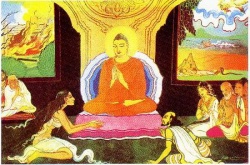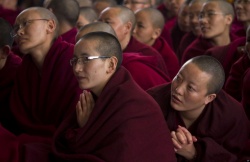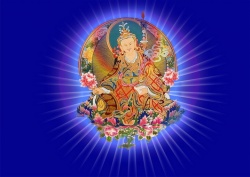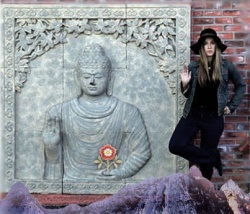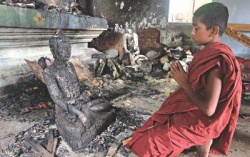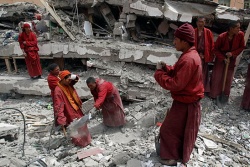Marriage in the Western Buddhist Order
What is marriage in the modern world? Of all the vast and sweeping changes that took place during the twentieth century in every department of life, perhaps the most immediate in its impact on our personal lives has been the steady decay of the traditional family. For the great majority of humanity, of course, one or other variety of traditional family is still the essential social unit, with strong clan loyalties and joint households combining several generations of blood relatives. However, in many areas of the modern West that form of family is already a distant memory. Even the nuclear family that replaced it is in decay, as the fervent outcries of bishops and government ministers attest. In Britain at least, the saving of the family — that is, by now, the nuclear family — is a live political issue.
Increasing wealth and economic efficiency, combined with technological invention, have greatly reduced domestic burdens. Reliable means of birth control and medical advances that have reduced infant mortality have relieved women of the pains and perils of frequent pregnancy and both parents of the cares of a large family. Modern methods of economic production and distribution have required a larger labour force and made gender differences more or less insignificant in the workplace, calling more and more women to full-time paid work. These factors have made the joint family less necessary as a means of sharing domestic and financial burdens and increased the viability of a separate, nuclear household. In addition they have helped to erode the traditionally distinct roles of men and women in the family. Political stability and the provision of welfare by the state have decreased social and economic insecurity, removing more needs for the joint family — and have made the single-parent family easier to sustain. Finally, combined with all these previous factors, modern notions of individual freedom and the decay of traditional sexual morality have undermined the idea of the sanctity and indissolubility of marriage. Sex outside marriage is quite normal, setting up a household and raising children without legal or religious ceremony is common, divorce is socially respectable, a single mother raising children on her own is not generally subject to stigma, and homosexual relationships are increasingly accepted. There is even a trend towards the legal recognition of homosexual marriage in the most liberal Western states, and there are active moves for homosexual couples, male or female, to be able to adopt and raise children. What indeed is marriage in the modern world? And how should a modern Western Buddhist movement view it?
The time has probably come for the FWBO to face up more fully to this question, especially as the lack of a clear position can be construed as anti-family, as some have argued. This is far from the case. Indeed, one of the founding principles of the Order is that ‘Commitment is primary, lifestyle secondary’, and the Order is, in contradistincition to most other Buddhist Orders, as much open to those who are married as to those who are single. In so far as there are married Order members (and in India they are the great majority) and they are not at all encouraged to neglect their family responsibilities, the Order cannot be anti-family. (Sangharakshita and others have spoken of the nuclear form of family as frequently having unwholesome aspects, but this has never been intended as a condemnation of the family per se — indeed he has recalled his experience of the Indian joint family with great warmth.) However, it is perhaps not surprising that the views on the family of Sangharakshita and his leading disciples have been misrepresented or misinterpreted. The fact is that, Dharma classes and retreats apart, the major institutional developments of our movement in the West in its first thirty years have been mainly led by single men and women predominantly for single men and women. One could say that our predominant institutional exploration to date has been of a quite new range of social possibilities opened up by the rapid and decisive changes in the structures of family life, sexual morality, and gender relations that became especially obvious in Britain in the late 1960s, when the movement was founded. This is one of the chief ways in which the modern West differs so radically from any culture Buddhism has ever before encountered.
Buddhism itself began within a traditional culture in which the extended family was the primary social unit, and so it has continued until it reached Europe and America. Even today in India our movement functions within that traditional context and almost all our Indian Order members are married or intend to marry, or else they must be committed to celibacy. In traditional Buddhist societies there has usually been but that choice between marriage and celibacy, and it has often been a choice on which there is no going back. In practice there has, of course, always been more of a grey area between the two choices: it is well known, for instance, that significant numbers of Theravadin bhikkhus have concubines and that homosexuality has often been tacitly accepted in the monasteries of several traditions. The fact is that few are ‘gifted’ with a spontaneous or easy calling to celibacy, and many accept it as the price to be paid for various other advantages, and are quite willing to find unofficial ways round it. But officially and generally the choice has been absolute, and the grey area has existed behind an appearance of conformity to celibacy — an often relatively benign form of hypocrisy that is nonetheless corrosive. Beneath the seemingly rigid conformity of most traditional societies a lot goes on that everyone knows about and accepts but no one acknowledges — until it becomes unavoidable and is execrated with cries of horror.
The situation for Buddhists in the West today is very different. As Philip Larkin ironically sings, ‘Sexual intercourse began / In nineteen sixty-three’ [1] . Around that time all the forces of technology, economics, politics, and ideology conspired to manifest the spectacular changes in sexual behaviour that are now so much an accepted part of social life in the West — and increasingly, and controversially, world-wide. Whilst there was much that was highly problematic about this moral explosion, it offered a quite new possibility for modern Buddhists. The grey area between celibacy and marriage need no longer be covert — it no longer need be grey at all, but a space of rainbow-hued possibility. It was possible to decide not to get married and raise a family and at the same time not have to give up sex — and without having to pretend one had done so. No doubt for many such a choice might be an individualistic self-indulgence, an avoidance of responsibility so that one is free to do whatever one wants to do, a kind of indefinitely prolonged adolescence. But for the seriously committed Buddhist it does offer the possibility of far greater freedom to live in communities, experiment with Right Livelihood enterprises, go away on retreat, devote oneself to study and meditation, and work to spread the Dharma and develop the Sangha’s institutions — all without becoming a monk or nun, which few seem able to do without an unhealthy degree of tension. If one remains single one has usually much more time available and needs much less money. Some have also argued that remaining unmarried lessens the intensity of romantic and familial attachment and leaves one emotionally freer for spiritual friendship.
Many of us who played a leading part in establishing the movement in those days embraced this possibility wholeheartedly and explored extensively the ‘middle-ground’ between marriage and celibacy, and are very happy that we have done so. Inevitably, where lust and love are concerned, all did not always go well, and we were often rather brash and even careless in our youthful experimentation, but we did mark out the foundations for new institutions — institutions in which it was possible to give much of our time and energy to spiritual practice of various kinds and to spreading the Dharma. We have not all remained squarely between those extremes of celibacy and marriage. The middle ground is inherently unstable, and if one is not actively moving towards celibacy one will tend to find oneself in a settled relationship, a kind of quasi-marriage without children, or one will start a family, perhaps without meaning to. However, even in the latter case, the decay of the traditional family structure, and even of the nuclear family, has allowed greater flexibility of parenting arrangements. Some have moved out of the middle ground into a more or less conventional nuclear family, but others have found ways of honouring their parental responsibilities whilst retaining something of the previous freedom of time and energy enjoyed in the middle ground. In some cases, something like a new kind of extended family structure has emerged, where both parents move easily in and out of residential communities or away on retreat, and children are quite happy to spend time with various Buddhist ‘aunts and uncles’.
There has been little formalising of these developments. We do, however, have a ceremony for those who wish to undertake life-long celibacy as Anagarikas, in recognition of the prime importance of celibacy for spiritual life. Anyone who is seriously pursuing the path will be working to overcome craving and attachment, and perhaps our strongest and most abiding longing is the sexual. Indeed, the Buddha says:
I know of no other single form, sound, scent, savour, and touch by which a man’s heart is so enslaved as it is by the form, voice, scent, savour, and touch of a woman. A man’s heart is obsessed by these things. And so is a woman’s heart enslaved and obsessed by those of a man. [2]
Sangharakshita teaches that brahmacharya or chastity is an aspect of going for Refuge, and all who are committed to the Three Jewels should be developing brahmacharya to some extent, whether or not they are sexually active, by diligently deepening their sources of fulfilment and cultivating contentment. Anagarikas have reached the point of being able to maintain physical chastity quite happily, and are working to further diminish their reliance on the senses as means of emotional satisfaction. Whilst Anagarikas have no superior status in the Order and movement, we have marked out the importance of celibacy by instituting a ceremony for those who are able to take on the precept of brahmacharya, and aspire to do so for the remainder of their lives.
But in the FWBO there have been, up to now in the West at least, no ceremonies for those who are in long-term sexual relationships or are forming families. Sangharakshita and his leading disciples have been reluctant to come to conclusions about what such ceremonies might be, because the general social situation is so fluid. We also do not wish to appear to condemn by omission any arrangements people might come to: if we formalise one kind of arrangement, then would those not covered feel disapproved of? Nor do we wish to appear to recommend any such choice as spiritually advantageous, as we have done in the case of the Anagarika ceremony, in case we mislead. We have consciously accepted as capable of being morally valid much of the range of possible sexual relationships. We have taken our stand on fundamental moral principles of non-exploitation or non-harmfulness and the gradual transcendence of craving. We have recognised that in practice sexual activity is always underlain by egoistic appetite, but that its forcible negation is unhealthy and leads to psychological distortion and social disruption. This being the case, it is best that people have an outlet for their sexual desire that is sensitive to others and not immoderate, and that they gradually learn to transcend their need by the development of deeper sources of satisfaction, especially through meditation. So we have wanted to leave individuals free to work these things out for themselves, without appearing to pick out one arrangement by formalising it.
However, as we have seen, the WBO and FWBO are firmly founded on the principle that ‘commitment is primary, lifestyle secondary (though not unimportant)’. We go for Refuge to the Three Jewels as individual men or women, not as ones who are single or married. The Order is open as much to those who are married, even in the most traditional sense, as to those who are not — and that principle is borne out by the facts: there are many married Order members, especially in India. If married people can be Order members, presumably marriage can be an arena for going for Refuge to the Three Jewels, for one must be making a spiritual effort in every area of one’s life to be eligible for ordination. Since in the world around us marriage of some kind is still the rule rather than the exception, should we not clarify in what sense a married life can be compatible with spiritual commitment and acknowledge that in certain cases people have embarked upon what can honestly be called a ‘Buddhist marriage’? But what in essence is a Buddhist marriage?
Let us begin by seeing what it is not. It is not a legal arrangement: for that provision is made by the state and it has nothing per se to do with Buddhism. If married couples see practical advantage to their marriages having legal status then they should seek that independently of the Buddhist marriage ceremony. Nor is it a religious sacrament, sanctifying an act that would otherwise be impure or sinful. That irreducible element of selfish craving in sex is not removed merely by holding a ceremony, and is rendered more or less skilful by attitudes and behaviour, not by the performance of a rite. What then is it? As the etymology of the word ‘wedding’ apparently suggests, it is a ‘pledge’, a vow or promise made by the parties to it, both to each other and to those who witness the ceremony. What makes it a Buddhist ceremony is the spiritual commitment of the participants — what Sangharakshita has taught us to identify as their going for Refuge to the Three Jewels. They make their marriage undertakings as a specific aspect of their broader and deeper undertakings and aspirations. For the vows they take to be at all sustainable, and therefore for the ceremony to have any real significance, their spiritual commitment must have reached an effective degree, so that they are able to keep their vows in the context of their going for Refuge to the Three Jewels. If that is not the case it is not truly a Buddhist wedding, since to be a Buddhist means to go for Refuge to the Three Jewels. This implies that both parties to a wedding within our movement should be members of the Order — or at least somewhat close to being so, for ordination is the recognition that one is going for Refuge effectively.
What is the essential content of the vow? Marriage has come to have such a broad range of meanings in the modern West that it is not easy to decide, especially as choice inevitably can be understood as prejudicial discrimination. There are two main components of marriage, which form the basis for the various modern understandings, and therefore for what one might be vowing: a relationship between two people and the raising of children. Today, the two elements are becoming detachable. For instance, there is a call for the legal recognition of homosexual marriage, whether there is an intention to adopt children or not. Should a Buddhist marriage focus on the relationship or the childrearing?
Whether the state should or should not recognise homosexual marriage, and therefore primarily define marriage in terms of a relationship, is not here in question. The point is what should we, in our spiritual community, recognise as a specifically Buddhist marriage. We have already seen that we acknowledge it to be a commitment, made in the light of a more fundamental commitment to the spiritual ideal. But to what extent can there be a Buddhist acknowledgement of a relationship? Presumably only to the extent that that relationship is primarily founded upon the parties to it being Buddhists — in other words, that they go for Refuge to the Three Jewels. For this we do already have a ceremony: the Kalyana Mitra ceremony, in which there is a pledge between two more senior members of the Order and either a more junior Order member or a mitra to be lifelong ‘spiritual friends’ — to relate to each other primarily as individuals who are following the spiritual path and to help each other in that endeavour. But where there is a question of marriage as a recognition of a relationship, spiritual commitment is not usually a major element in what brings the couple together at all. Sex and romance are what is foremost. Although both parties may be spiritually committed, they come together because they are attracted to each other for quite different reasons. Our experience in the movement in the West has so far shown that such relationships are seldom enduring, for attraction by itself is very unstable. I do not wish to deny that sexual and romantic attraction ever matures into serious spiritual companionship, but that has been remarkably rare in our experience in the movement. It seems unlikely that the holding of a ceremony to acknowledge such sexo-romantic relationships would therefore be either real or helpful. If those who are in a sexual relationship wish to pledge themselves to sexual fidelity, they could perhaps do so less formally, and accept that the relationship will very likely end at some point, and try to make sure it does so in as sensitive and considerate a way as possible. But that does not constitute a Buddhist marriage.
We are left then with the other component of our usual understanding of the term marriage as its essential characteristic: the raising of children. Of course, there is a relationship, but the relationship is based upon the decision to raise children together. Although the couple may initially have been attracted to each other for reasons of love and lust, they have decided that they want to be partners in the serious enterprise of raising children. They want to take on that responsibility together. Their vows to each other are made in the context of that responsibility. What makes the marriage a Buddhist one is the fact that they see the raising of any children they might have in the light of their common spiritual commitment. They have decided that they want to try to raise their children so that they become decent human beings who are happy and fulfilled and who can play a useful role in society. That means that they will train them ethically and try to make sure they have the intellectual and cultural equipment to live full and satisfying lives. Their ultimate hope will be that their children will commit themselves to the spiritual path. They will know that such commitment must be the free act of an individual, but they will do their best to help them mature as healthy individuals who are capable of making that choice for themselves. This work is a weighty responsibility and demands high vision and sustained effort. In effect it is the taking up of the Bodhisattva’s task, requiring parents to rise above their personal interests and preferences by helping other beings to realise their highest potential. Above all it demands commitment and partnership.
If a Buddhist marriage consists in a vow made between two committed Buddhists who intend to raise children in the light of their going for Refuge to the Three Jewels, what are they vowing? Essentially they are undertaking sexual fidelity to each other as the fundamental basis for family life. Successful parenting and sexual fidelity do not invariably go together: there are, it would seem, ‘open marriages’ in which children are raised well, and sometimes when couples ‘stay together for the sake of the children’ the resulting disharmony in the home does the children little good. However, on the whole, the taking of other lovers is very likely to lead to a lessening of partnership, and most often will be accompanied by jealousy and not infrequently by extreme and destructive tension. Besides, from a Buddhist point of view, a commitment to fidelity is a commitment to overcoming sexual craving, since one is agreeing to curb one’s appetites by committing oneself to developing sexual contentment within one’s marriage. Those who have made the marriage vow can set aside all other options and possibilities, at least until children reach adulthood, and consciously work at keeping their promises successfully. This must surely greatly simplify their lives and thereby aid spiritual endeavours.
Whilst a vow of sexual fidelity is the principal content of a marriage ceremony, that itself implies a commitment to treating each other as individuals who are dedicated to the spiritual path, in a spirit of mutual respect and appreciation. In other words, the element of kalyana mitrata should be present in their relationship. That then provides the context for working together to raise children. These three — fidelity, respect, and partnership — are what most likely make a genuine and successful Buddhist marriage.
Fidelity, respect, and partnership in the context of going for Refuge to the Three Jewels can be seen as the essence of a Buddhist marriage in the modern West, but they need imply no particular formal arrangement. The husband and wife need not, for instance, always have a common household — it might be that both parents chose to live in separate single-sex communities, for instance. There is still a great deal of room for experimentation and variety in the present very fluid social circumstances — although the interests of the children must be at the forefront of any decisions that are made. Similarly, no particular roles need be assigned to husband or wife in the ceremony: no ‘love, honour, and obey’, as in the old Anglican service, or the husband being bound to give the wife ornaments, as in the Sigalovada Sutta. They may share responsibilities equally or they may apportion them between them. Who does what, however, should surely not be decided on any doctrinaire basis, whether of a traditionalist or postmodern kind. Decisions should be made according to circumstances, aptitude, and inclination, not being afraid to pay close attention to the natural differences that are generally observed between men and women in relation to children.
It is clear by now that I am thinking of the parties to a marriage ceremony being a man and a woman, who intend to have children or already have had them. But there is the very modern question of homosexual couples who intend to raise children. Why should not the Buddhist marriage ceremony within the FWBO be open to them too? There certainly seems no reason in principle why they should not be good parents and, in the FWBO generally, we have no moral objection to homosexuality in itself. I do not wish to imply any disapproval of those who might make this choice, however, as yet in our movement we have no experience of its consequences for the spiritual life of the ‘parents’ or the well-being of children. No Order members have yet undertaken it. It is probably best that we confine ourselves for the time being to what we have already observed and see the need to clarify and acknowledge.
So in the FWBO Buddhist marriage ceremony, a man and a woman, who either want to have children or already have them, make a vow of sexual fidelity to each other, pledge themselves to mutual respect, and undertake to work together as partners in raising children. But what is the context for them making these promises? It is of course the spiritual community and movement within which they Go for Refuge to the Three Jewels. They, as it were, take their vows before that community and thereby bring into being a set of interlocking duties. In the first place they will seek the advice and the blessings of their spiritual friends, whose duty is to ensure that they fully understand what they are undertaking and that they are ready to do so. (In the case of Order members this would imply discussing the matter with their Order Chapters, Kalyana Mitras, and Preceptors. The local Order Chapter and Mitra Convenor would have the duty of satisfying themselves, in the case of Mitras, that they are sufficiently dedicated to the spiritual ideal to enter a truly Buddhist marriage.) These blessings should not be lightly given, and the proposed couple’s friends and teachers should thoroughly examine motives and aspirations in the light of their experience of the individuals concerned. Once the ceremony has been performed, those who have accepted and witnessed it become guarantors of the vows. If the couple have difficulties in their marriage they will involve their friends and teachers in helping them to overcome them, since these people have their interests at heart and have a duty to intervene if they see that the vows are not being kept, or that they are in danger. By virtue of the ceremony, the marriage is no longer a private affair, and the husband and wife have a duty to the spiritual community to make it successful and the spiritual community has a duty to help them do so.
This then is the proposal of the Public Preceptors’ College, after consultation with Sangharakshita and members of the College Council. There should be a marriage ceremony in the WBO in the West, in which a vow of sexual fidelity is made, together with a commitment to deepening mutual respect and partnership in raising children. The parties to the ceremony should be a man and a woman, one at least of whom is an Order member and the other at least a Mitra approaching ordination, who either already have a family or intend to start one. Those seeking a marriage ceremony should have the blessings of their Chapters, Kalyana Mitras, and Preceptors or Mitra Convenor, who will then have a duty to help the couple maintain their vows. We are still considering the precise form a wedding ceremony might take and are open to advice. We propose that anyone who is thinking of marrying in this way contacts a Public Preceptor to discuss the matter further. We will work out the procedures and ceremonies as experience unfolds.
We have chosen a quite strict interpretation of what is a Buddhist marriage, since we want to be sure that it is meaningful as the act of individuals fully committed to the spiritual path. We are not offering a mere Buddhist gloss on an ordinary social occasion. We realise that many who might want a Buddhist ceremony will not fall under this definition, and we want to be clear that we imply no judgement on the nature and value of their marriages. A serious Buddhist who marries a committed Christian or an agnostic who is morally upright may have a very successful marriage and raise children admirably, but it will not be a Buddhist marriage, in our definition. Similarly, two homosexual Order members may decide to raise a child together and do it very satisfactorily, keeping their spiritual commitment always to the fore — but here we would be entering new territory and wish to see whether such undoubtedly exceptional circumstances do occur. Mitras and members of the Order may decide to have a civil wedding, and there can be no objection to that — although we do not think that Buddhists should be married according to any rite that involves them in saying anything that compromises their going for Refuge, even implicitly. Our definition of a Buddhist wedding within the FWBO is not intended to criticise other forms of marriage, but to establish a formal context for the raising of children by a husband and wife who share effective commitment to the Three Jewels in the context of our particular spiritual community.
We hope that this clarifies our approach to the question of a Buddhist marriage, at least for the time being. We view parenthood as a weighty responsibility that needs to be entered upon with great and serious attention, and that involves undertakings on which there should be no going back. Far from being the easy option when compared with the single life in singles-sex communities and working situations, it demands, if anything, far greater energy and determination if it is to be a truly Buddhist marriage — an expression of the Bodhisattva Ideal. Anyone entering upon this responsibility will need to consider very carefully what they are doing and to make sure they are able to avail themselves as much as possible of the support and encouragement of the single-sex institutions that have been primarily established by those who are not married. If they do so successfully they will show an example of what family life can be in the modern age, and perhaps give a Buddhist answer to the questions clergymen and politicians are so earnestly debating.
Originally published in Madhyamavani: Spring 2000 Issue 3 (Birmingham: Madhyamaloka, 2000).

